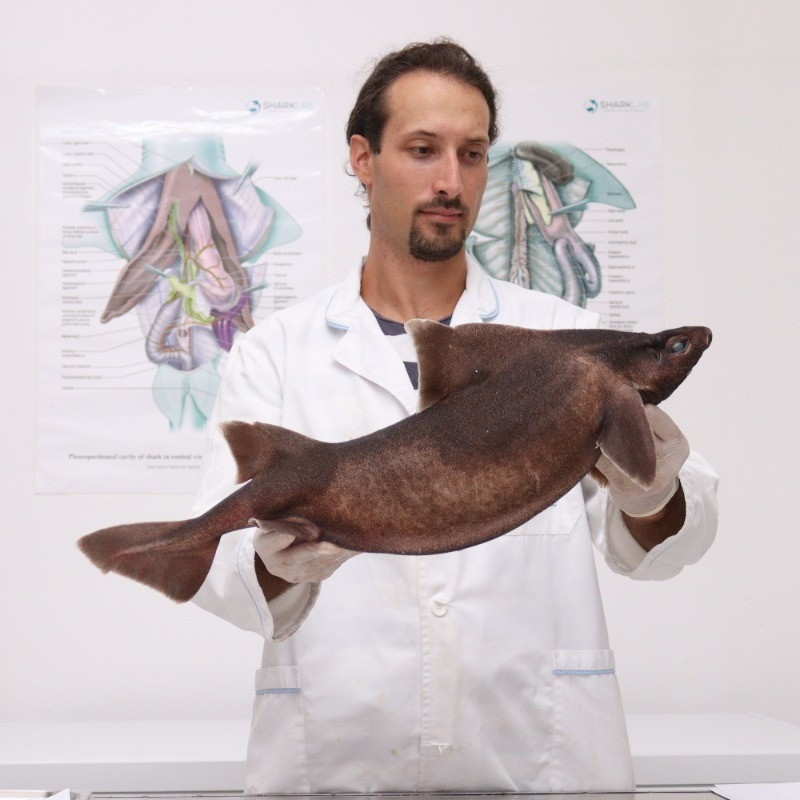
National Geographic
Polje Istraživanja: Marine biology Pathology (Biology) Anatomical pathology Histopathology Veterinary medicine
Abstract Developmental abnormalities in elasmobranchs (sharks and rays) are rarely documented, with reported cases primarily involving fin or cranial deformities. Monozygotic twinning, the formation of identical twins from a single zygote, is particularly rare in these species and has been observed overwhelmingly in viviparous elasmobranchs. Here, we document a rare case of monozygotic twinning in an oviparous shark, the Small‐spotted Catshark Scyliorhinus canicula (Linneaus, 1758). This case was characterized by two embryos connected to a single yolk sac via separate yolk stalks within the egg capsule. The embryos exhibited normal development until mortality at developmental Stage 31 (Ballard et al., 1993) or stage 4 (Musa et al., 2018), likely due to stressors such as oxidative stress and allostatic overload, resulting from shared resources within the capsule. This is the first confirmed instance of mortality in monozygotic elasmobranch twins, highlighting the plausible challenges of polyembryony in oviparous elasmobranchs. These findings underscore the importance of understanding reproductive abnormalities and their implications for fecundity, particularly in light of ongoing anthropogenic pressures that threaten elasmobranch populations globally.
This study documented the first evidence of healing and long‐term survival of blackmouth catsharks (Galeus melastomus) following traumatic mandibular fractures and associated soft tissue avulsions that resulted from previous captures on deep‐sea longlines. All sharks were actively feeding, despite acute and healed lesions, which suggests that such severe trauma did not impair feeding. Additionally, one female with a healed lesion and three developed eggcases indicated that reproduction was unaffected. Magnetic resonance imaging (MRI) showed no other alterations in the chondrocranium, splanchnocranium, or broader skeletomuscular system and major viscera. Although the small sample size does not fully represent postrelease survival for the species after capture in longline fisheries, the resilience observed was significant for conservation and fisheries management, which underscores the need for further research.
The capture of a rare, critically endangered adult angular rough shark, Oxynotus centrina (Linnaeus, 1758), with abnormal coloration is reported in this paper. The shark exhibited a partial reduction in pigmentation, resulting in an overall pale appearance with white-greyish patches. Since the retinal pigmentation appeared normal, the shark was considered leucistic. This represents the first documented case of leucism in this species and the first colour disorder reported in the family Oxynotidae Gill, 1912. Despite the atypical appearance, the physical health of the shark seemed unaffected, supporting the notion that pigment disorders in deep-sea sharks do not inherently impair survival and growth. Full morphometric characteristics are presented and compared with those of a normal individual of the same sex caught in the same area, showing no differences.
The sharpnose sevengill shark (Heptranchias perlo) is a rare and poorly understood deep‐sea species, with only a few records in the Adriatic Sea over the last two centuries and a significant gap in sightings. Throughout 2023, three new records are documented in the southernmost Adriatic Sea, found at depths ranging from 391 to 452 m off Vlorë. This study marks the first comprehensive health examination of a deep‐sea shark, investigating potential trauma and injuries resulting from trawling. It encompasses pathological and histopathological examinations, supplemented by magnetic resonance imaging (MRI). The research highlights alarming post‐capture mortality rates in this data deficient species, discusses further conservation implications, and proposes protective measures for the species. Beyond addressing critical knowledge gaps, this study advocates for collaborative efforts with local fishermen to establish long‐term monitoring and obtain data on the frequency and abundance of elusive species.
This paper describes the first record of the critically endangered gravid female Spiny butterfly ray, Gymnura altavela (Linnaeus, 1758), in the northern Mediterranean and simultaneously the only record of the species in this century for the Adriatic Sea. The female (173 cm disc width and 43.25 kg total weight) was captured at approximately 200 m, off Vlorë in the southern Adriatic Sea off Albania on 12th of May 2022. Upon necropsy, seven near-term fetuses (mean 328 ± 6.47 mm disc width and mean 355 ± 20.06 g in total weight) were transported for further in-vitro incubation. These results represent the deepest capture for the species, as well as the largest litter size and largest size at birth in the Mediterranean Sea which indicates the need for further research.
Ova stranica koristi kolačiće da bi vam pružila najbolje iskustvo
Saznaj više